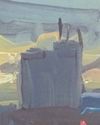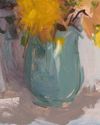
Diaries can have all sorts of purposes. With the growing popularity of bullet journals, sketchbooks, and gratitude diaries, their positive effect on mindfulness and mental health are widely promoted. To keep a journal in some form is a popular ambition but rarely seen beyond the first few pages, which is understandable; writing an entry every day can seem a daunting commitment. In addition to this, numerous artists and hobbyists aspire to regular practice in the form of a daily sketchbook. Many of these books end up unfinished – or worse, not started – tucked away on a bookshelf, first page still intimidatingly blank. How do you form this habit and stick to it? And how do you get past the first hurdle?
Tea diaries are a great solution to these dilemmas and an example of how your daily journal doesn’t have to take the standard “Dear diary” format.
It is a well-known stereotype that the British drink tea, and it is entirely true for many. We drink tea morning, noon, and night; sometimes five cups a day. We drink it at work, in the garden, and on a train; we greet strangers with it and offer it to loved ones, on good days, bad days, and truly awful days. It is this that makes it the perfect companion to a diary. The routine of regular tea (or coffee) breaks is already incorporated into our daily lives and associated with the ups and downs which that entails. You don’t need to start a new habit from scratch, just alter your preexisting one with the inclusion of drawing.
هذه القصة مأخوذة من طبعة February 2022 من Artists & Illustrators.
ابدأ النسخة التجريبية المجانية من Magzter GOLD لمدة 7 أيام للوصول إلى آلاف القصص المتميزة المنسقة وأكثر من 9,000 مجلة وصحيفة.
بالفعل مشترك ? تسجيل الدخول
هذه القصة مأخوذة من طبعة February 2022 من Artists & Illustrators.
ابدأ النسخة التجريبية المجانية من Magzter GOLD لمدة 7 أيام للوصول إلى آلاف القصص المتميزة المنسقة وأكثر من 9,000 مجلة وصحيفة.
بالفعل مشترك? تسجيل الدخول

Still life IN 3 HOURS
Former BP Portrait Award runner-up FELICIA FORTE guides you through a simple, structured approach to painting alla prima that tackles dark, average and light colours in turn

Movement in composition
Through an analysis of three masterworks, landscape painter and noted author MITCHELL ALBALA shows how you can animate landscape composition with movement

Shane Berkery
The Irish-Japanese artist talks to REBECCA BRADBURY about the innovative concepts and original colour combinations he brings to his figurative oil paintings from his Dublin garden studio

The Working Artist
Something old, something new... Our columnist LAURA BOSWELL has expert advice for balancing fresh ideas with completing half-finished work

Washes AND GLAZES
Art Academy’s ROB PEPPER introduces an in-depth guide to incorporating various techniques into your next masterpiece. Artwork by STAN MILLER, CHRIS ROBINSON and MICHELE ILLING

Hands
LAURA SMITH continues her new four-part series, which encourages you to draw elements of old master paintings, and this month’s focus is on capturing hands

Vincent van Gogh
To celebrate The Courtauld’s forthcoming landmark display of the troubled Dutch master’s self-portraits, STEVE PILL looks at the stories behind 10 of the most dramatic works on display

BRING THE drama
Join international watercolour maestro ALVARO CASTAGNET in London’s West End to paint a dramatic street scene

Serena Rowe
The Scottish painter tells STEVE PILL why time is precious, why emotional responses to colour are useful, and how she finds focus every day with the help of her studio wall

Bill Jacklin
Chatting over Zoom as he recovers from appendicitis, the Royal Academician tells STEVE PILL about classic scrapes in New York and his recent experiments with illustration